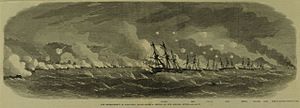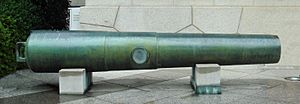Bombardment of Kagoshima facts for kids
Quick facts for kids Bombardment of Kagoshima |
|||||||
|---|---|---|---|---|---|---|---|
| Part of the Bakumatsu | |||||||
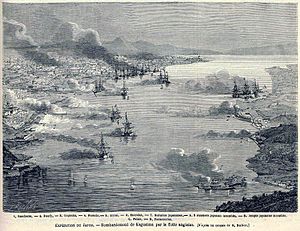 Bird's-eye view of the bombardment of Kagoshima by the Royal Navy, August 15, 1863. Le Monde Illustré. |
|||||||
|
|||||||
| Belligerents | |||||||
| Commanders and leaders | |||||||
|
|
|||||||
| Strength | |||||||
| 7 warships | 1 coastal battery | ||||||
| Casualties and losses | |||||||
| 13 killed 59 wounded 3 warships damaged |
5 killed 3 merchant ships destroyed |
||||||
| 5 junks destroyed | |||||||
The Bombardment of Kagoshima, also known as the Anglo-Satsuma War (薩英戦争, Satsu-Ei Sensō), was a battle between Britain and the Satsuma Domain in Kagoshima, Japan. It happened from August 15 to 17, 1863. The British wanted money and justice from the Satsuma leader, Shimazu Tadayoshi. This was because of an event in 1862 called the Namamugi Incident. During that event, a British fleet led by Sir Augustus Leopold Kuper was shot at by Satsuma cannons near Kagoshima. The British fired back, attacking the city. They did not win a clear victory and left two days later. The Satsuma people said they won. After talking, they met some of Britain's demands for the Namamugi Incident.
Contents
Why the Battle Happened
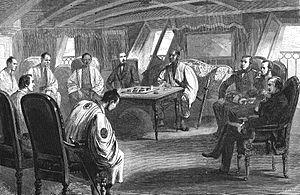
On September 14, 1862, a British merchant named Charles Lennox Richardson was killed in Japan. He was traveling near Kawasaki, Kanagawa and got into a fight with the group of Shimazu Hisamitsu. Hisamitsu was the father and leader of the Satsuma area. Richardson did not move out of the way of Hisamitsu's group. So, Hisamitsu's guards killed him. They used a traditional right called Kiri-sute gomen. This allowed samurai to kill people from lower classes who showed disrespect.
Westerners in Japan were very angry about Richardson's death. They had special rights called extraterritoriality. This meant they were not under Japanese laws. These rights came from ""unequal treaties"".
Edward St. John Neale, a British diplomat, demanded an apology from the Bakufu. The Bakufu was Japan's central government. He also demanded £100,000 as payment for Richardson's death. This was a huge amount, about a third of the Bakufu's yearly income. Neale also said he would attack Japan's capital, Edo, with warships if the money was not paid. He also demanded that the Satsuma Domain arrest the people who killed Richardson. He wanted another £25,000 for Richardson's family and others hurt in the incident.
At that time, the Bakufu was led by Ogasawara Nagamichi. The main leader, Shogun Tokugawa Iemochi, was away. Ogasawara wanted to solve the problem quickly. On July 2, 1863, he talked with France and Britain on a French warship. Neale, along with French leaders, was there. Ogasawara apologized for the killing and paid the £100,000.
However, the Satsuma Domain refused to meet Neale's demands. They would not apologize or pay the £25,000. They also would not put the samurai on trial. They said that disrespecting a leader usually meant death. But, Westerners were not under Japanese laws because of the treaties.
During this time, there were many fights between Westerners and Japanese people. This was partly because of Emperor Kōmei's "Order to expel barbarians" in 1863. The Kanmon Straits saw attacks on American, Dutch, and French ships. These countries sent their own warships to fight back.
More Talks and British Departure
After more than a year of talks with Satsuma, Neale was fed up. His British leaders told him to use military force. So, he ordered Kuper to make Satsuma obey.
On August 5, a Japanese official from Edo visited Neale. He even said the Japanese government might send a warship to help Kuper. But this ship never joined the British.
Kuper's Royal Navy fleet left Yokohama on August 6. It included his main ship, HMS Euryalus, and six other ships. They sailed to Kagoshima and arrived on August 11. Satsuma leaders came to Kuper's ship. They exchanged letters, and Kuper demanded a solution within 24 hours. But the Satsuma leaders kept delaying and refused to agree.
The Bombardment
When Kuper's deadline passed, he decided to punish Satsuma. His ships moved and took three British-built merchant ships in Kagoshima harbor. These ships belonged to Satsuma and were worth £200,000. Kuper planned to use them to get Satsuma to agree.
The Satsuma military waited for a typhoon to start. Then, they began firing their cannons at the British ships. The city had been emptied before the attack. The British were surprised. Kuper's ships quickly took valuable items from the captured merchant ships. Then, they set the merchant ships on fire.
The British spent about two hours getting their ships ready for battle. They had not expected to fight. Then, they formed a line and sailed along the Kagoshima coast. They fired shells and round shot at the coastal cannons. Fire from one British ship also burned five trading junks from the Ryukyu Kingdom. These junks were not part of the battle.
The British slowly silenced the Satsuma cannons. But Kuper's ships were running low on supplies and ammunition. He had not expected a long fight. So, he ordered his ships to leave. Five Satsuma people were killed. On the British side, 13 were killed and 69 were hurt. This included Captain Josling and his second-in-command, who were both killed by the same cannonball.
About 500 houses in Kagoshima were destroyed by the bombing. This was about 5% of the city. The Ryukyuan embassy building was also destroyed. The British leaving made Satsuma feel like they had won. They looked at the number of people killed on each side. Kuper's ships did not land soldiers or take the cannons. He decided the bombing was enough.
After the Battle
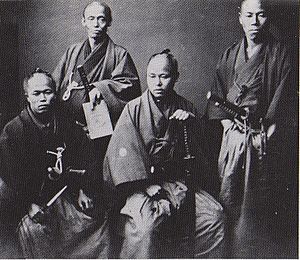
Satsuma eventually agreed to Neale's demands. They paid £25,000 to the British. They borrowed this money from the Bakufu. But they never paid it back. This was because the Tokugawa government fell in 1869. The new Meiji government took over. Satsuma never found or put Richardson's killers on trial.
Even so, Britain was happy with the payment. They signed a deal with Satsuma to give them steam warships. It's interesting that this conflict actually started a friendship between Satsuma and Britain. They became important allies in the Boshin War that followed. The Satsuma Province had always been open to new ideas and Western ways. A famous Japanese admiral, Tōgō Heihachirō, was a teenager during this battle. He was helping to load one of the cannons. He later said this moment inspired his career as a naval leader.
See also
- Ishibashi Park
- Japan–United Kingdom relations
- Shimazu clan




